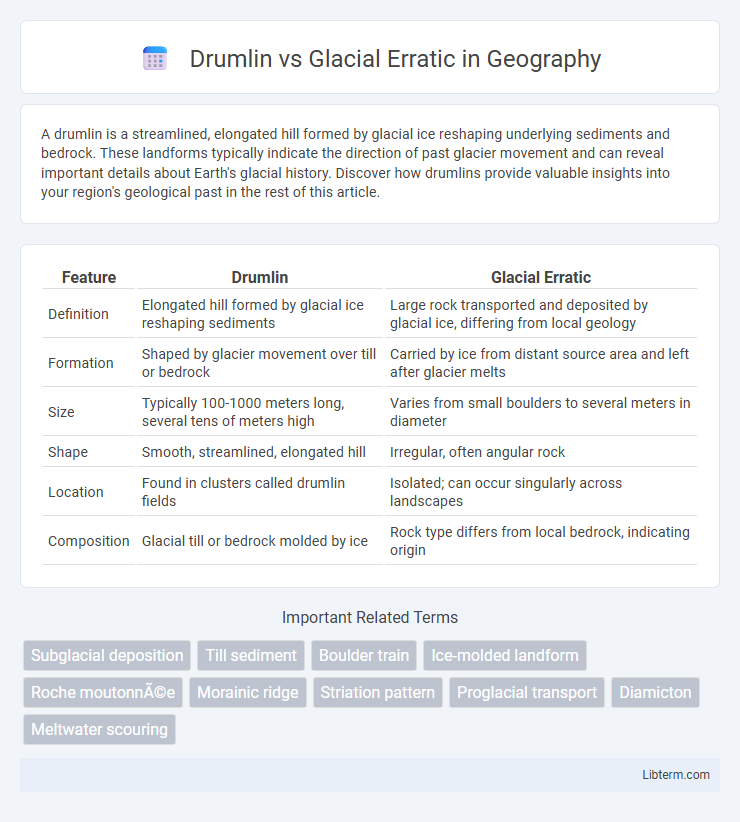A drumlin is a streamlined, elongated hill formed by glacial ice reshaping underlying sediments and bedrock. These landforms typically indicate the direction of past glacier movement and can reveal important details about Earth's glacial history. Discover how drumlins provide valuable insights into your region's geological past in the rest of this article.
Table of Comparison
| Feature | Drumlin | Glacial Erratic |
|---|---|---|
| Definition | Elongated hill formed by glacial ice reshaping sediments | Large rock transported and deposited by glacial ice, differing from local geology |
| Formation | Shaped by glacier movement over till or bedrock | Carried by ice from distant source area and left after glacier melts |
| Size | Typically 100-1000 meters long, several tens of meters high | Varies from small boulders to several meters in diameter |
| Shape | Smooth, streamlined, elongated hill | Irregular, often angular rock |
| Location | Found in clusters called drumlin fields | Isolated; can occur singularly across landscapes |
| Composition | Glacial till or bedrock molded by ice | Rock type differs from local bedrock, indicating origin |
Introduction to Glacial Landforms
Drumlins are streamlined, elongated hills composed of glacial till formed beneath moving ice sheets, indicating ice flow direction and glacial dynamics. Glacial erratics are large boulders transported and deposited far from their source by glacial ice, often resting on different types of bedrock. Both features serve as key indicators in studying past glacial activity and landscape evolution during ice ages.
Defining Drumlins: Shape and Formation
Drumlins are streamlined, elongated hills formed by glacial ice molding underlying sediments into smooth, oval shapes, typically measuring between 1 to 3 kilometers in length and 300 to 600 meters in width. Their distinctive tapered shape, with a steep stoss slope facing the direction of glacier movement and a gently sloping lee side, results from subglacial processes such as sediment deformation and deposition. Drumlins serve as key indicators of past glacial flow patterns, contrasting with glacial erratics, which are isolated boulders transported and deposited by glacial ice without shape modification.
What is a Glacial Erratic?
A glacial erratic is a large rock or boulder transported and deposited by glacial ice, often distinct from the local geology. These erratics provide key evidence of past glacial movement, revealing the direction and extent of ice flow during the last Ice Age. Unlike drumlins, which are streamlined hills formed from glacial till, glacial erratics are isolated fragments left behind as glaciers retreat.
Origins and Geological Processes
Drumlins form through the reshaping of glacial till beneath moving ice sheets, creating elongated hills aligned with the direction of ice flow, primarily composed of compacted sediments. In contrast, glacial erratics are large rocks or boulders transported far from their source by glacial ice and deposited randomly as the glacier melts. The formation of drumlins involves subglacial deformation and deposition processes, whereas erratics result from glacial plucking and transport.
Physical Characteristics: Drumlins vs. Glacial Erratics
Drumlins are streamlined, elongated hills composed primarily of glacial till, typically oriented in the direction of ice flow, with smooth, gently sloping sides that narrow at the tail. Glacial erratics are large, isolated boulders of varied lithology, transported and deposited by glacier movement, often resting on surfaces of different rock types. Unlike drumlins, erratics are not shaped by glacial flow but serve as indicators of glacier transport paths and melting patterns.
Locations and Distribution Worldwide
Drumlins predominantly occur in regions once covered by continental ice sheets, such as North America's Great Lakes area, parts of Scandinavia, and northern Europe, displaying elongated hills shaped by glacial movement. Glacial erratics are widely distributed across glaciated landscapes worldwide, including North America, Northern Europe, and parts of Asia, characterized by isolated rocks transported far from their origin by ice. The spatial distribution of drumlins is concentrated along former ice sheet margins, while erratics can be scattered over vast areas, reflecting ice flow paths and melting patterns.
Functions in Glacial Geology
Drumlins are streamlined hills formed beneath glaciers that indicate the direction of ice movement and help reconstruct past glacial flow patterns. Glacial erratics are large boulders transported and deposited by glaciers, serving as key indicators of glacier transport distances and ice dynamics. Both features contribute valuable information for understanding glacier behavior and landscape evolution during glaciation.
Importance in Environmental Studies
Drumlins and glacial erratics provide critical data for reconstructing past glacial movement and climate patterns, essential for understanding environmental change. Drumlins indicate the direction and speed of ice flow, helping scientists model glacier dynamics and predict future shifts in glacial landscapes. Glacial erratics serve as indicators of ice transport distances and source areas, aiding in the analysis of sediment provenance and landscape evolution in environmental studies.
Key Differences: Drumlin vs. Glacial Erratic
Drumlins are streamlined, elongated hills composed of glacial till formed beneath moving glaciers, typically aligned in the direction of ice flow, whereas glacial erratics are isolated boulders transported and deposited far from their source by glacial ice. Drumlins often appear in swarms called drumlin fields, providing insight into past glacial dynamics, while glacial erratics vary in size and composition, serving as indicators of glacier transport paths. The key difference lies in their formation processes and shapes: drumlins are depositional landforms shaped by ice movement, whereas glacial erratics are individual rocks transported and left behind by retreating glaciers.
Conclusion: Understanding Glacial Legacies
Drumlins and glacial erratics both reveal vital insights into past glacial movements and landscape transformations, with drumlins serving as streamlined hills molded by ice flow and glacial erratics as isolated boulders transported far from their origin. These geological features collectively enhance the understanding of glacial legacies by providing tangible evidence of ice sheet dynamics and sediment deposition patterns. Studying these formations contributes significantly to reconstructing paleoenvironments and predicting future glacial impacts on Earth's surface.
Drumlin Infographic

 libterm.com
libterm.com